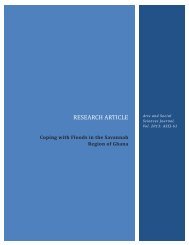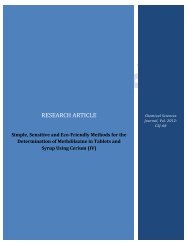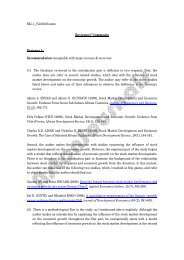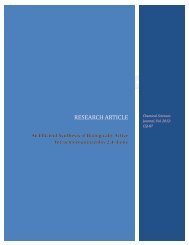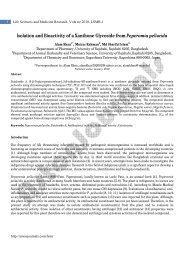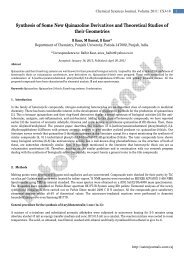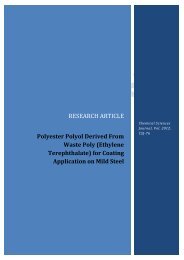Rapid and Sensitive Spectrophotometric ... - AstonJournals
Rapid and Sensitive Spectrophotometric ... - AstonJournals
Rapid and Sensitive Spectrophotometric ... - AstonJournals
Create successful ePaper yourself
Turn your PDF publications into a flip-book with our unique Google optimized e-Paper software.
4 Research Article<br />
2.2 Materials<br />
Pharmaceutical grade propranolol hydrochloride (PPH) was received from Cipla India Ltd., Mumbai, India, as a gift<br />
<strong>and</strong> used as received. The following formulations were obtained from commercial sources <strong>and</strong> subjected to<br />
analysis: Monoprolol-20 (Cosmo Life Sciences Ltd., India), Ciplar – 40 (Cipla Ltd., India) <strong>and</strong> Betacap-40 from (Sun<br />
Pharma Ltd., India).<br />
2.3 Reagents <strong>and</strong> chemicals<br />
All the reagents <strong>and</strong> solvents used were of analytical-reagent grade. Bromothymol blue (BTB), bromocresol green<br />
(BCG) <strong>and</strong> bromocresol purple (BCP) (all from Loba Chemie Ltd., Mumbai, India) solutions were prepared daily as<br />
0.1% BTB <strong>and</strong> BCP <strong>and</strong> 0.05% BCG in dichloromethane.<br />
2.4 St<strong>and</strong>ard stock solution of PPL<br />
Pure propranolol hydrochloride (11.4 mg) was dissolved in 20 ml water in a 125 ml separating funnel, 5 ml of liquid<br />
ammonia was added followed by 20 ml of dichloromethane. The content was shaken for 15 minutes. The lower<br />
organic layer was collected in a beaker containing anhydrous sodium sulphate. The water-free organic layer was<br />
transferred into a 100 ml calibrated flask <strong>and</strong> diluted to the volume with the same solvent to get 100 µg ml -1 with<br />
respect to PPL (hydrochloride free propranolol). This solution was diluted appropriately with dichloromethane to<br />
get working concentrations of 10 µg ml -1 in both the methods A <strong>and</strong> B, <strong>and</strong> 12 µg ml -1 for use in method C,<br />
respectively.<br />
2.5 Recommended Procedures<br />
2.5.1 BTP method (method A)<br />
Different aliquots (0.2, 0.5, 1.0, 2.0, 3.0 <strong>and</strong> 3.5 ml) of a st<strong>and</strong>ard PPL (10 µg ml -1 ) solution were transferred into a<br />
series of 5 ml calibrated flasks using a micro burette <strong>and</strong> to each flask was added 1 ml of 0.1% BTB solution. The<br />
mixture was diluted to the volume with dichloromethane <strong>and</strong> mixed well. The absorbance of resulting yellow<br />
colored solution was measured at 420 nm against a reagent blank.<br />
2.5.2 BCG method (method B)<br />
Varying aliquots (0.2, 0.5, 1.0, 2.0, 3.0 <strong>and</strong> 3.5 ml) of a st<strong>and</strong>ard PPL (10 µg ml -1 ) solution were transferred into a<br />
series of 5 ml calibrated flasks using a micro burette <strong>and</strong> to each flask was added 1 ml of 0.05% BCG solution. The<br />
mixture was diluted to the volume with dichloromethane <strong>and</strong> mixed well. The absorbance of resulting yellow<br />
colored solution was measured at 425 nm against a reagent blank.<br />
2.5.3 BCP method (method C)<br />
Into a series of 5 ml calibration flasks, aliquots (0.25, 0.5, 1.0, 2.0, 3.0 <strong>and</strong> 3.5 ml) of st<strong>and</strong>ard PPL solution (12 µg<br />
ml -1 ) equivalent to 0.6 – 8.4 µg ml -1 PPL were accurately transferred <strong>and</strong> the total volume in each flask was brought<br />
to 3.5 ml by adding dichloromethane. To each flask 1 ml of 0.1 % BCP solution in dichloromethane was added <strong>and</strong><br />
mixed well. The absorbance of the yellow colored ion-pair complex was measured at 420 nm against the reagent<br />
blank.<br />
2.5.4 Procedure for dosage forms<br />
Ten tablets or content of ten capsules were weighed accurately <strong>and</strong> ground into fine powder. An amount of the<br />
powder equivalent to 11.4 mg of PPH was weighed into a 125 ml separating funnel. The extraction procedure used<br />
for pure drug was followed for tablet/capsule powder. The resulting solution was diluted to get working<br />
concentration (10 <strong>and</strong> 12 µg ml -1 PPL) <strong>and</strong> suitable aliquots were analyzed following the procedures described<br />
above.<br />
2.5.5 Procedures for selectivity study<br />
A placebo blank of the composition: talc (100 mg), starch (50 mg), acacia (50 mg), methyl cellulose (100 mg),<br />
sodium citrate (50 mg), magnesium stearate (100 mg), <strong>and</strong> sodium alginate (50 mg) was prepared <strong>and</strong> 20 mg was<br />
extracted with dichloromethane <strong>and</strong> solutions were made as described under preparation of dosage forms. A<br />
convenient aliquot of solution was subjected to analysis following the recommended procedures.<br />
http://astonjournals.com/csj



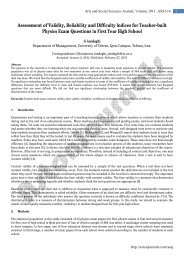
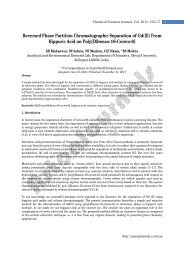
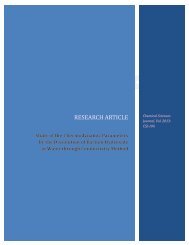
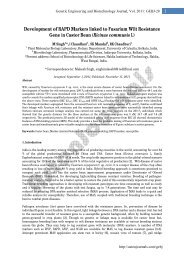
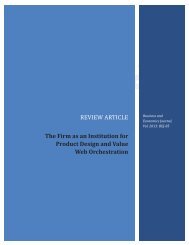
![[1,4]-benzodiazepine-2-one Derivatives as Potent - AstonJournals](https://img.yumpu.com/49117784/1/184x260/14-benzodiazepine-2-one-derivatives-as-potent-astonjournals.jpg?quality=85)
